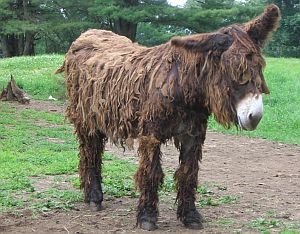
(Host) We hear a great deal about saving endangered wild animals, but what about threatened farm animals?
One Vermonter is doing her part to preserve a rare donkey from France on her farm in Hartland – and thanks in part to her efforts, its making a comeback. .
VPR’s Steve Zind paid a visit to the Hamilton Rare Breeds Foundation.
Check out the Hamilton Rare Breeds photo gallery
(Sound of door closing, engine starts)
(Zind) Take a ride along the cart paths that wind through Debbie Hamilton’s Windsor County farm and you notice two things right away: The rolling fields with their sturdy fences, the big handsome horse barn and even the scattered outbuildings are all remarkably well kept. And there are some pretty unusual animals here.
(Hamilton) "Its 440 acres and I have probably 20 Dales ponies and a dozen Choctaw Mustangs. All of these are critically rare. What I’m interested in conserving is the farm animals."
(Zind) We’ve come to the Hamilton Rare Breeds Foundation today to see one particular breed. It hails from the time of Samuel de Champlain and comes from the same area of western France where Champlain was born.
(Hamilton) "Alright, we’ll stop here and we’ll look at this animal. This is a baudet du Poitou. And that’s French. Baudet means jackass, which is a male breeding donkey. And it also has the connotation of being a mule producer, a baudet. And we need to get this straight right now for the listeners: A mule, and this is important, is a sterile hybrid. To produce one you have to have a donkey father and a mare mother."
(Zind) What made the male Poitou donkey – the baudet du Poitou – so valuable in its heyday was the fact that the mules it sired were large, sturdy, hardworking and required less feed than their equine counterparts.
This baudet de Poitou is named Norman. He’s one of 35 Poitou’s on Hamilton’s farm and he exhibits all the traits of the breed, preserved unchanged for 700 years.
(Hamilton) "He’s about eight years old. He’s a fairly good specimen of the breed. Important in the Poitou donkey is the size of the foot and the size of the bone, it should be like a small draught horse. Ok, also the size of the ear, which must be wide and open."
(Zind) But none of those features are what you’ll notice first when you come face to face with your first Poitou. What stops you dead in your tracks is its coat. A well-bred Poitou looks like Eeyore with dreadlocks. Not just a few long braids of hair, but many – hanging from all over its body. The more the better.
(Sound of donkeys braying)
(Zind) In the past century, mules and donkeys came to represent an era when farm work was a backbreaking enterprise. They became symbols of rural poverty. Hamilton says that’s not always been the case. The Poitou donkey and its mule offspring were once the prized possessions of the well-to-do.
(Hamilton) "In the middle ages, which is when the history of the Poitou mule and the Poitou donkey began, the mule interestingly enough was considered very, very valuable animal. Usually the yeoman did not have one. The people who had them were usually the nobility and the clergy because they were the wealthy ones."
(Zind) Ironically it was the Poitou’s value that nearly led to its extinction. There never were a large number of them to begin with. The people who owned the donkeys guarded them jealously, so they could corner the market on the valuable mules they produced.
(Hamilton) "If somebody wanted a Poitou mule, and all of Europe did, they had to buy it from the breeders, they couldn’t produce their own."
(Zind) Eventually farm mechanization and war took its toll on the breed. By 1970 only 40 pure Poitous remained in the world. Now, thanks to people like Hamilton, the species has begun to rebound and today there are about 1200.
The French government keeps a close eye on efforts to restore the breed and maintains a registry of the animals.
Hamilton says preservation of endangered domestic animals deserves just as much attention as we give to saving wild species.
Hamilton says we should be concerned that many species of domestically raised animals and plants are disappearing. She says its important to preserve breeds like the Poitou in order to maintain a gene pool that is both wide and deep.
(Hamilton) "Biodiversity. Biodiversity. Everytime you lose something, the pool shrinks. And this is the same with… she’s interrupted by donkeys braying)…this is the same with plants, in other words, if a weakness springs up in a breed, if its wheat rust in wheat, if its bone deficiency in dairy cattle, if you need to breed that out and these are all gone, you have nothing to breed it out with."
(Zind) Hamilton has a background as a horse trainer. She discovered the Poitou when she saw a photograph in a magazine. She says she gets requests for people who want to adopt a Poitou, but a good home isn’t enough. What’s needed are people who are serious about helping to increasing the numbers of the difficult to breed animal.
Two of Hamilton’s Poitous now live at the Wichita, Kansas zoo and recently two more took up residence at the Franklin Park Zoo in Boston. One of them is named Samuel – after the famous explorer from western France who may himself have once admired the donkey with the big ears and the long hair.
(Zind) For VPR news, I’m Steve Zind in Hartland.